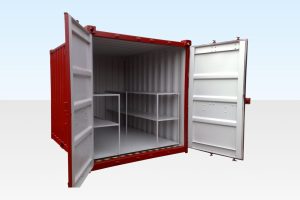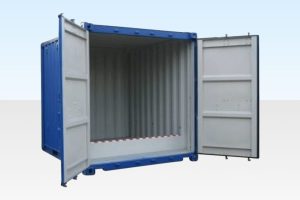How to safely transport or store hazardous liquids to prevent spills
In today’s industrial landscape, managing hazardous liquids isn’t just a best practice—it’s a legal and ethical imperative. The critical challenge is how to safely transport or store hazardous liquids to prevent spills. From fuels to chemicals, improper handling poses significant risks to personnel, property, and the environment. This is where bunded storage containers step in as an indispensable safety solution for countless applications.
What Exactly Are Bunded Storage Containers?


10 x 8ft Flat Floor Bunded Store 10ft x 8ft Raised Bunded Store
At their core, bunded containers provide secondary containment. Imagine a container holding a hazardous liquid. A bund acts as an outer shell or basin designed to catch any spills and leaks from the primary container. This ingenious design prevents dangerous substances from escaping into the soil, groundwater, or drainage systems, protecting both the environment and your operational site. They are a critical part of any comprehensive spill prevention and pollution control strategy.
Manufacturers craft these vital units from robust, chemically resistant materials such as high-grade polyethylene (HDPE), ideal for corrosive acids and alkalis, or sturdy steel, commonly used for oil storage containers, fuel storage, and flammable liquids.
Why Are They So Crucial? The Core Benefits
The importance of bunded storage containers cannot be overstated. Their primary function is threefold:
-
- Environmental Protection: Bunded containers defend against pollution. They contain spills, stopping harmful substances. This protects natural resources and ecosystems. It also prevents costly cleanups. This is crucial for environmental compliance.
- Workplace Safety: Minimize exposure to hazardous chemicals and oils. Directly protect your workforce. Bunded containers reduce risks like slips and falls. They also prevent chemical burns and inhalation hazards. This creates a safer work environment. They are essential workplace safety equipment.
- Regulatory Compliance: Regulations mandate secondary containment for hazardous materials. Invest in certified bunded storage solutions. This ensures your operation meets strict requirements. Avoid hefty fines and legal issues.
A Range of Solutions for Every Need: Bunded Containers for Sale
The market offers a diverse array of bunded storage containers tailored to various applications and capacities:
- Drum Bunds & Spill Pallets: Perfect for individual drums or small groups of containers, these portable units offer immediate spill prevention at the point of use.
- IBC Bunds: Specifically designed to accommodate Intermediate Bulk Containers (IBCs), providing robust containment for larger volumes, particularly useful in industrial spill containment scenarios.
- Bunded Cabinets: Secure, often lockable units for smaller quantities of chemicals, ideal for indoor or outdoor chemical storage.
- Walk-in Bunded Stores: These larger structures provide secure, weatherproof environments for multiple drums or IBCs, often featuring ventilation and shelving, making them excellent industrial spill containment solutions for bulk storage.
- Bunded Shipping Containers: Modified containers offer highly robust and portable hazardous liquid storage for bulk quantities. These are often used for temporary storage and safe handling during the transportation of hazardous chemicals or dangerous goods to and from remote construction sites or other temporary operations.
Key Uses and Applications Across Industries
Bunded storage containers aren’t just useful; they’re absolutely vital across countless industries and sectors! They unlock safe, critical handling for every hazardous liquid you can imagine. Think about it: from securing everyday fuels like diesel and petrol to containing a vast range of oils (lubricants, hydraulic fluids) and potent chemicals like acids, alkalis, and solvents—these containers are on the front lines, protecting your operations and our environment.
Specific applications where bunded containers are used include:
- Manufacturing Plants & Warehouses: For the safe segregation and containment of various oils and hazardous chemicals used in production processes, contributing to overall industrial safety.
- Agricultural Sector: Crucial for the secure storage for agricultural chemicals like fertilizers and pesticides on farms, preventing runoff into water sources and ensuring environmental protection.
- Automotive Workshops & Garages: Essential for waste oil collection, storing lubricants, brake fluids, and fuels safely.
- Construction Sites: Preventing ground contamination from fuels, hydraulic fluids, and paints, crucial for environmental compliance on site.
- Logistics & Transportation Hubs: For safe temporary storage and transfer of dangerous goods and materials being prepared for shipment or after delivery, ensuring leak prevention during transit.
- Waste Management Facilities: For the controlled handling, segregation, and storage of various liquid wastes, including hazardous waste, forming vital waste management solutions.
- Laboratories & Research Facilities: For secure containment of diverse chemical reagents and waste.
- Mining Operations: Providing robust storage for fuels, oils, and process chemicals in challenging environments.
Wherever hazardous or polluting liquids are handled, bunded containers provide the critical secondary containment required to meet regulations and protect both personnel and the environment.
Choosing Your Ideal Bunded Storage Container
When looking to buy bunded storage container, consider these factors:
- Type of Liquid: Ensure the container’s material (e.g., polyethylene for corrosives, steel for flammables) is compatible with the stored substance.
- Capacity: The bund must hold at least 110% of the largest container’s volume. Alternatively, it must hold 25% of the total volume stored, whichever is greater, to meet common regulatory standards.
- Location: Indoor versus outdoor use influences features like covers, drainage, and security.
- Regulations: Always verify local and national environmental regulations and safety standards that apply to your specific industry and location.
Invest in Safety, Invest in Compliance
Choosing the right bunded storage containers is a proactive step towards a safer, more compliant, and environmentally responsible operation. By preventing spills, protecting personnel, and ensuring regulatory adherence, these essential spill containment containers offer peace of mind and significant long-term value. They are an indispensable component of workplace safety equipment and environmental protection.
Ready to enhance your safety protocols? Explore our range of bunded storage containers for sale today and find the perfect solution for your hazardous liquid storage and waste management needs.
